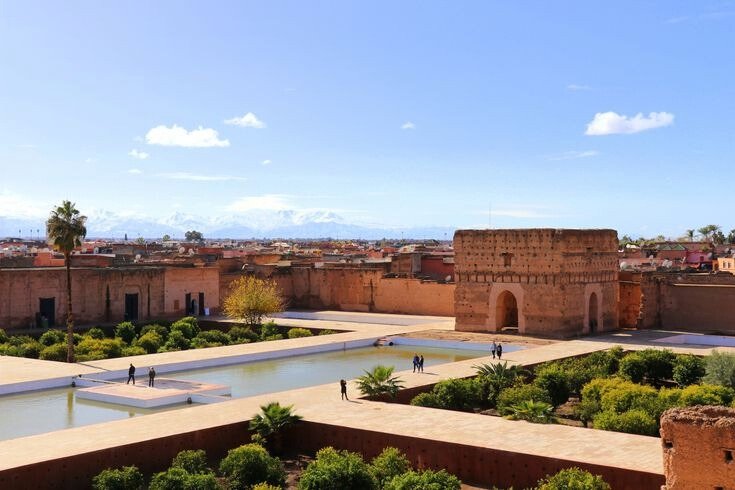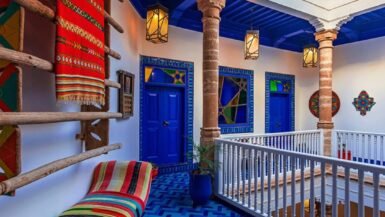Although it stands today as majestic ruins, El Badi Palace in Marrakech tells the story of incredible glory and a golden period in Morocco’s history. This imposing palace bears witness to the power and wealth of the Saadian Dynasty, symbolizing an architectural ambition rarely equaled.
This comprehensive guide aims to explore the fascinating history of El Badi Palace, from its construction to its transformation into ruins, describing what visitors can see among its remains today, explaining its historical significance, and providing practical information for visiting. Though it’s a “palace,” today it’s an archaeological site in ruins, yet it remains impressive thanks to its enormous scale and remaining elements.
History of El Badi Palace: Construction of Glory and Its Decline
The story of the construction and decline of El Badi Palace is one of the most fascinating in the history of Marrakech and its monuments, telling of a period of prosperity and wealth, followed by a period of deterioration and disappearance.
Sultan Ahmad al-Mansur al-Dhahabi: The Visionary
El Badi Palace was built by the great Saadian Sultan Ahmad al-Mansur al-Dhahabi following his victory at the Battle of Wadi al-Makhazin (Battle of the Three Kings) in 1578. This victory was a turning point in the history of the Saadian Dynasty, strengthening its position and power on the international stage and bringing immense wealth in spoils and tribute.
Purpose of Construction and Duration of Works
The main purpose of building El Badi Palace was to celebrate the Saadian victory and showcase the Sultan’s immense wealth and power. Various precious materials were used in its construction, such as gold, Italian marble, ivory, and valuable cedar wood. The palace’s construction took approximately 25 years and cost a colossal fortune, so much so that historians recount that when al-Mansur asked his architect about the cost of construction, the architect replied: “My lord, only God knows.”
Why Is El Badi Palace in Ruins?
Approximately 75 years after its construction, El Badi Palace was dismantled by the Alaouite Sultan Moulay Ismail in the late 17th century. Moulay Ismail used the precious materials from El Badi Palace to build his new capital in Meknes, which is why only the basic structure of walls, courtyards, and pools remains today, in what is now known as the ruins of El Badi Palace.
Architecture of El Badi Palace: Imagining Splendor from the Ruins
Although most of its precious ornaments have been moved, the structural layout and strength of construction at El Badi Palace still allow visitors to imagine its original grandeur and the ambitious architectural vision behind its creation.
General Layout and Vast Area
El Badi Palace extends over a vast area of approximately 130 meters by 110 meters, with a large central courtyard surrounded by numerous smaller courtyards, pavilions, stables, and underground chambers. Its symmetrical design reflects various architectural influences, with elements from Andalusian, Moroccan, and Eastern Islamic architecture, making it a unique architectural masterpiece in the history of Moroccan architecture.
Main Remaining Features: Courtyards, Pools, and Walls
Among the most notable features of the ruins of El Badi Palace today:
- The Main Courtyard: a vast space with the Great Pool in the center featuring a small island in the middle, used for celebrations and official events.
- The Surrounding Walls and remains of former rooms and pavilions, which give an idea of the immensity of the original building.
- The Small Pools scattered throughout different parts of the palace, which were part of an advanced irrigation and cooling system.
- The Underground Chambers and Stables beneath the earth, which can be visited and explored.
- The Original Minbar from the Koutoubia Mosque, sometimes exhibited here, an artistic masterpiece from the 12th century.
One of the characteristic scenes at El Badi Palace is also the presence of storks nesting on the high walls, adding a touch of natural life amidst these historical ruins.
Imagining the Original Decorations and Materials
At its height, El Badi Palace was adorned with sumptuous decorations of Italian marble, North African marble stone, gold, ivory, and precious woods. These luxurious materials contrast with the simple state of the ruins today, but some remnants of carvings and mosaics can be found in scattered parts, giving a glimpse of the palace’s former splendor.
Significance of El Badi Palace: Symbol of the Saadian Golden Age
El Badi Palace holds great importance as:
- A symbol of the wealth, power, and artistic peak of the Saadian Dynasty under the rule of Ahmad al-Mansur al-Dhahabi.
- A testament to architectural ambition and the use of various precious materials, reflecting Morocco’s extensive trade and diplomatic connections at that time.
- A site directly linked to the Battle of Wadi al-Makhazin, a pivotal event in Moroccan history and Moroccan-European relations.
- An essential component of the UNESCO World Heritage site in the Medina of Marrakech.
Visiting El Badi Palace: Practical Guide and What to Expect
El Badi Palace is one of the monuments worth visiting to imagine the grandeur of the past. Here’s a practical guide on what to expect when visiting El Badi Palace.
Palace Location and How to Get There
El Badi Palace in Marrakech is located in the southern part of the Marrakech Medina, near the Kasbah area. It’s close to the Saadian Tombs and the Bahia Palace. It can be easily accessed on foot from Jemaa el-Fna Square (approximately 15-20 minutes walking) or by taxi to a nearby drop-off point.
The exact location of El Badi Palace: It’s located approximately 800 meters south of Jemaa el-Fna Square and can be reached via Bab Agnaou Street.
Opening Hours of El Badi Palace
El Badi Palace typically opens from 9:00 AM to 5:00 PM, seven days a week. Hours may vary during the month of Ramadan or on holidays, so it’s advisable to check current hours before visiting El Badi Palace.
Palace Entrance Fees
The standard entrance ticket price for El Badi Palace is approximately 70 Moroccan dirhams. There may be additional fees for special exhibitions. It’s recommended to check current prices before visiting, as they may change from time to time.
What to Expect When Visiting the Ruins
When visiting El Badi Palace, it’s important to manage expectations – it’s a site of ruins, not a furnished palace like the Bahia Palace. The experience includes:
- Walking through the vast courtyards and enjoying the open spaces
- Observing the large pools that showcase the advanced water system
- Exploring the underground areas (chambers)
- Walking atop the walls for views of the city
- Observing the storks nesting on the high walls
- Imagining the original grandeur of the palace
A visit to El Badi Palace typically takes between one hour and an hour and a half to explore the main areas.
Best Time to Visit
The best time to visit El Badi Palace is early in the morning when the weather is cooler and the place is less crowded, or late afternoon to enjoy the sunset colors over the ruins. It’s preferable to avoid midday during the hot summer months.
Monuments Near El Badi Palace
El Badi Palace is located in an area rich with historical monuments, making it part of a broader tour of the southern part of the Marrakech Medina.
The Saadian Tombs
The Saadian Tombs are located a very short distance from El Badi Palace and are directly related to the Saadian Dynasty. This royal necropolis houses the remains of members of the Saadian royal family, including Ahmad al-Mansur al-Dhahabi himself. It is distinguished by its beautiful decorations and remarkable carvings.
The Bahia Palace
The Bahia Palace is a short distance from El Badi Palace and dates back to the 19th century. Unlike El Badi Palace, the Bahia Palace is well-preserved and furnished, offering a contrasting and complementary experience. The two palaces are often visited together for a deeper understanding of the evolution of palace architecture in Marrakech.
The Mellah
The Mellah, the historic Jewish quarter, is located near the palace area. Visitors can explore this unique neighborhood after visiting El Badi Palace to discover the cultural diversity that characterized Marrakech through the ages.
Conclusion: El Badi Palace… A Window to the Saadian Era of Glory
Although in ruins today, El Badi Palace in Marrakech remains an amazing site that allows visitors to connect with an important period of Moroccan history and imagine its past splendor. Its enormous size and remaining elements make it a worthwhile visit and an experience rich in historical atmosphere.
We invite you to visit El Badi Palace and use your imagination to bring its history to life, explore the majestic ruins of El Badi Palace, and share your own impressions of this unique historical monument. Through these silent ruins, we can hear the echo of a story of great glory and a well-established civilization that left its mark on the history of Morocco and the world.






Leave a reply